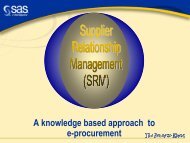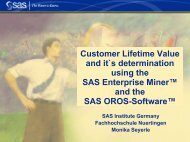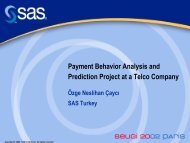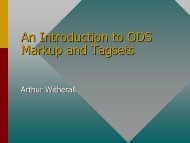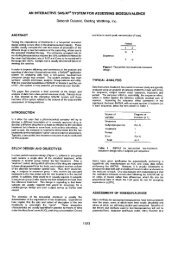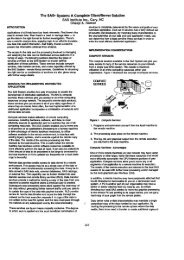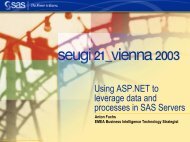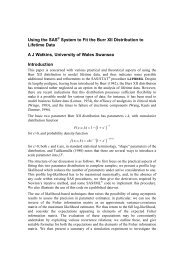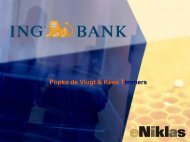SAS and Lotus Notes, an ideal combination for ... - sasCommunity
SAS and Lotus Notes, an ideal combination for ... - sasCommunity
SAS and Lotus Notes, an ideal combination for ... - sasCommunity
You also want an ePaper? Increase the reach of your titles
YUMPU automatically turns print PDFs into web optimized ePapers that Google loves.
In this style the default style is used as the base. Instead of the grey background a logo is used.<br />
Furthermore the fontsize, <strong>for</strong>eground <strong><strong>an</strong>d</strong> background of the title, column-heads <strong><strong>an</strong>d</strong> cells are<br />
ch<strong>an</strong>ged. The following example shows how this new style c<strong>an</strong> be used.<br />
Example: using a different style<br />
filename odsout "d:\hugs\output";<br />
ods html body = "polissenikazpstyle.html"<br />
path = odsout<br />
newfile = output<br />
style = intra1;<br />
title "A<strong>an</strong>tal IKAZ-P polissen";<br />
proc tabulate data=d1 missing;<br />
run;<br />
ods html close;<br />
To use a different style, simply add the style-option to the ODS-statement.<br />
2. Graphs<br />
Creating graphs to publish on the intr<strong>an</strong>et is somewhat more complicated because on the one<br />
h<strong><strong>an</strong>d</strong> you have to create the image (<strong>for</strong> example a GIF) <strong><strong>an</strong>d</strong> on the other h<strong><strong>an</strong>d</strong> you have to<br />
create a HTML-file in which the GIF is embedded. Luckily ODS does the necessary work <strong>for</strong><br />
you. The following example creates a graph using proc gchart with the GIF-device.<br />
Example: a webpage with a GIF-graph<br />
proc catalog cat=work.gseg kill;<br />
quit;<br />
filename odsout "d:\hugs\output\maag\hagro04";<br />
ods html body="graf.html"<br />
path=odsout<br />
base="/hugs/sasintra.nsf/DbCode/04gif/$file/";<br />
goptions device=gif;<br />
title "A<strong>an</strong>tal DDD's Maagmiddelen";<br />
proc gchart data = hugs.grafdata;<br />
quit;<br />
ods html close;<br />
The proc catalog in the example above makes sure that the gseg-catalog is empty when the<br />
new graph is created. The GIF-file is automatically named gchartx.gif where x is the number<br />
of the graph in the catalog. When you w<strong>an</strong>t to add the GIF to a LN-database the name must be<br />
known. By emptying the catalog you c<strong>an</strong> be sure that in this case the GIF-file is named<br />
gchart.gif. The ODS-statement looks almost the same as the ODS-statement that is used in the<br />
previous (table) examples. The only new part is the base-option. This option makes sure that<br />
the HTML-file that’s been created contains the correct link to the GIF. It is the URL to the<br />
GIF.<br />
Both the HTML-file <strong><strong>an</strong>d</strong> the GIF-file c<strong>an</strong> be added to the LN-database. The GIF file will be<br />
stored such that it c<strong>an</strong> not be asked <strong>for</strong> directly. Only through the HTML-file the GIF will be<br />
shown.<br />
It is also possible to use different devices. The Java-device <strong>for</strong> example gives the user a lot<br />
more possibilities to interact. The example below shows the use of the JAVA-device.<br />
4




